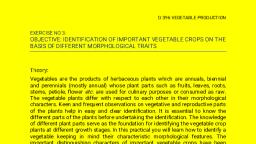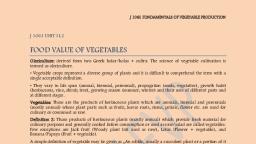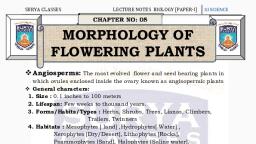Page 1 :
J 3061: FUNDAMENTALS OF FRUIT PRODUCTION, J 3061 UNIT || EL8/05092020/11:30-12:15 PM, BEARING HABIT, In nature, plant species flowers produce fruits and seeds and the primary objective is to, reproduce them. Plant species those are unable to produce viable seeds, reproduce, themselves by other means. With a common of these processes they vary in various, aspects of flowering and fruiting. The variations may be due to their different growing, habits, requirement of different environments, differences in their basic nature etc. Here, we are going to discuss different types of bearing habits do exists in fruit crops., Growth habit, Growth is quantitative irreversible increase in the existing size of say plant or a shoot or, simply a leaf etc. Fruit crops can be classified on the basis of their growth habits in two, major classes. One is evergreen and second is deciduous. Evergreens include those, plants which bear their leaves throughout the year. Examples are mango, litchi, guava, and orange. Whereas, deciduous trees shed their leaves during a part of year (when, weather is adverse i.e. during winter). Mostly temperate fruits belong to this category., The presence or absence of leaves makes very big difference in their physiology, their, bearing season and pattern etc. These two categories also make a basic group to study, them separately with respect to many aspects viz. source and sink relationships,, pruning etc., Bearing habit, The bearing habit of a species can be described by the location and types of buds which, produce flower and fruit (Gardner et al., 1952). Now the question is that why do plant, bear at a particular location? As plants attains proper nutritive condition particularly, accumulation of certain carbohydrates upto desired level, any bud can differentiate to, flower bud and set fruit. In various plant species, different buds located at different, locations (on a shoot) varies to attain this condition. The justification of formation of, fruiting buds on particular locations in a particular species is that at those locations the, nutritive and other conditions are more favourable for flower bud formation. Since all, the buds can be considered as potential flower buds. So, flowers, inflorescence and, finally fruits will bear wherever buds are borne., They can be located:, 1. Terminally on long or short growths, 2. Laterally in the axils of the current or past season leaves, DR R CHANDRA, ASSISTANT PROFESSOR, DEPARTMENT OF HORTICULTURE, AMAR SINGH COLLEGE, LAKHAOTI, BULANDSHAHR, W Edit with WPS Office
Page 2 :
J 3061: FUNDAMENTALS OF FRUIT PRODUCTION, 3. Adventitiously from any point on the exposed bark of limbs, trunks or roots, (Gardner et al.,1952)., If we not consider the location of the fruit bud, whether it is present terminal or lateral., After it unfolds it may give rise three basic type of flower-bearing structures:, 1. It may contain flower parts only and develop a single flower (peach) or a flower, cluster (cherry) without leaves., 2. It may be a mixed bud and develop a short or long leafy shoot terminating in an, inflorescence (apple)., 3. It may be mixed and develop a short or long leafy shoot bearing flowers or flower, clusters in some of its leaf axils (persimmon) (Gardner et al., 1952)., When we combine the above mentioned bud locations and bud type, there will be six, groups mainly. Fruits may be classified under these six groups according to their, bearing habits., Classification of fruit plants according to bearing habits, Six distinct bearing habits, the classification being based upon the location of the fruit, buds and the type of flower-bearing structure to which they give rise (Gardner et al.,, 1952)., Fruit Buds Terminal, Fruit Buds Lateral, Flower, bud Group-l:, Group-IV:, containing, flower, Fruit buds borne terminally. It In this group, fruit buds produce, parts contains flower parts only and laterally. They contain flower parts, rise, produces inflorescence without only, leaves.(Fig.1), to, inflorescence without leaves or if, leaves are present their size is, only, and, giving, Examples: Mango, Loquat, reduced. (Fig.4), Examples: Peach, Plum, Apricot,, cherry, Almond, Walnut (staminate, flower), Pecan (staminate flower),, Date, Coconut, Citrus fruit, Plumcot,, Flower, mixed, bud Group-ll:, buds, Current, Gooseberry, Group-V:, borne terminally, Fruit buds borne laterally, unfolding, Flowering shoot unfolding to produce leafy shoots to produce leafy shoots that, terminal that terminate in flower clusters terminate in flower clusters (Fig. 5)., Fruit, with, inflorescence, .This bearing habit is, characteristics of most of the, pome fruits.(Fig.2), DR R CHANDRA, ASSISTANT PROFESSOR, DEPARTMENT OF HORTICULTURE, AMAR SINGH COLLEGE, LAKHAOTI, BULANDSHAHR, W Edit with WPS Office
Page 3 :
J 3061: FUNDAMENTALS OF FRUIT PRODUCTION, Examples: Apple(principally) PearExamples: Litchi, Black berry, Rasp, (principally), Quince Walnut(P.F.),berry, Dew berry, Grape, Filbert,, Реcan (P.F.), Blue berry, Cranberry, (European),, Brazilnut, Pond apple (and, various, Cashewnut,, other, annonaceous, fruits), Apple (occasionally),, Pear (occasionally)., Group-VI:, Fruit buds borne laterally (or, bud Group-ll:, Flower, mixed, Flowering Fruit buds borne terminally, after, shoot with lateral unfolding they produce leafy psudoterminally),, inflorescence, unfolding, to, shoots with flowers or flower produce leafy shoots with flower, clusters in leaf axils.This might be clusters in the leaf axils (Fig. 6)., called an incomplete terminal, bearing habit for the fruit itself is Examples:, not borne terminally, but is lateral Persimmon,, to the growths upon which it Cranberry (American), Chestnut,, appears. However, the flower Pistachio nut, Star- apple, Avocado,, buds are terminal. The terminal Olive (Partly)., buds of the flowering shoots may, differentiate flower parts for the, following year"s production or, new buds may develop from, lateral leaf buds (Fig.3)., Examples: Pomegranate, guava,, tropical almond, olive, Eugina., Jujube, Mulberry,, (Ber),, Fig,, Group- I: Fruit buds borne terminally, containing flower parts only and giving rise to, inflorescences without leaves (Examples: Mango and Loquat), Bearing habit of this group can understand very clearly form mango. In mango,, harvesting the shoots grows and matures and produces panicle terminally. Growth of, lateral branches situated below panicle is continued. In case of accident to terminal, panicle, then some of axillary buds may differentiate flower parts.This bearing habit is, not found with any of the common deciduous fruits., after, Group- II: Fruit buds borne terminally, unfolding to produce leafy shoots that terminate, in flower clusters, [Examples: Apple (principally), Pear (principally), Quince, Walnut (P.F.), Pecan (P.F.)], This type of bearing habit is characteristic of most of the pome fruits. It can be, understand very well with example of apple and pear. Majorly, apple and pear, bears on, spurs (commercial crop of good quality and quantity). These spurs bear fruit buds, terminally. These spurs bear for many years (varies according to varieties). New spurs, DR R CHANDRA, ASSISTANT PROFESSOR, DEPARTMENT OF HORTICULTURE, AMAR SINGH COLLEGE, LAKHAOTI, BULANDSHAHR, W Edit with WPS Office
Page 4 :
J 3061: FUNDAMENTALS OF FRUIT PRODUCTION, originate from lateral buds on the shoots of the preceding season and very occasionally, from latent of adventitious buds on the trunk or older limb. However, in some varieties, of apple which is young and vigorous, many of long shoots form terminal flower buds., But, they contribute very less to total commercial crop of that tree., Group-III: Fruit buds borne terminally, unfolding to produce leafy shoots with flowers, or flower clusters in the leaf axils, [Examples: Guava, pomegranate, tropical almond, olive, Eugina)., This is an incomplete terminal bearing habit because the fruit itself is not borne, terminally, but is present laterally on the growth. However, the flower buds are terminal., The terminal buds of the flowering shoots may differentiate flower parts for the, following year"s production or new buds may develop from lateral leaf buds. In guava,, the fruit buds are formed on short shoots (current season growth) and flower and fruits, produced in the leaf axils., Group-IV: Fruit buds borne laterally, containing flower parts only and giving rise to, inflorescences without leaves or if leaves are present they are much reduced in size., [Examples: Peach, Plum, Apricot, cherry, Almond, Walnut (staminate flower), Pecan, (staminate flower), Date, Coconut, Citrus fruit, Plumcot, Current, Gooseberry]., This type of bearing habit can easily understand by examples of peach and citrus fruit, (Kinnow mandarin). In Kinnow mandarin, the fruit buds borne laterally on old season, shoot and after emergence it produces flower bud (s) and few leaves. In case of, peaches, the shoot of previous season produces flowers on laterally without leaves., Group-V: Fruit buds borne laterally, unfolding to produce leafy shoots that terminate in, flower clusters., [Examples: Litchi, Black berry, Rasp berry, Dew berry, Grape, Filbert, Blue berry, Cranberry, (European), Cashewnut, Brazilnut, Pond apple (and various other annonaceous fruits),, Apple (occasionally), Pear (occasionally)]., Bearing habit of group -V can understand by example of litchi. Litchi produces fruit, buds laterally which produces leafy shoots which ultimately produces panicles, terminally. In case of grapes, the fruit buds borne laterally which produces shoot and, this shoot actually bears berry cluster terminally (which makes fit for this group) but as, shoot grows further, its growth pushes fruit cluster in one side and it gives appearance, as it is situated laterally and opposite a leaf., Group -VI: Fruit buds borne laterally (or pseudoterminally), unfolding to produce leafy, shoots with flower cluster in the leaf axils., [Examples: Jujube (Ber), Persimmon, Mulberry, Fig, Cranberry (American), Chestnut,, DR R CHANDRA, ASSISTANT PROFESSOR, DEPARTMENT OF HORTICULTURE, AMAR SINGH COLLEGE, LAKHAOTI, BULANDSHAHR, W Edit with WPS Office
Page 5 :
J 3061: FUNDAMENTALS OF FRUIT PRODUCTION, Pistachio nut, Star- apple, Avocado, Olive (Partly)]., Ber is very good example to understand this type of bearing habit. Ber produces various, current season shoots from old pruned shoots laterally. These branches bear flower, clusters in the leaf axils. After fruit ripening, the leaves and fruits fall and ultimately the, branch falls. Buds for the next season crop will produced by strictly vegetative branches., It indicates dimorphism in branching of ber. First type of branches are permanent in, mature and forms basic framework for a tree. Second types of branches are deciduous, in nature and they dry out after producing flowers and fruits in a season., Apart from these six main groups, there are three more classes, having distinctness to, classify in separate groups., Group VII: In this type of bearing habit, the fruit buds can be terminal and lateral,, inflorescence is generally terminal. The fruit crops discussed in group I| and IV can cite, here. But it is more convenient to discuss them separately in group II and IV., Group VIII: This group has very different kind of bearing habit in which fruit buds are, adventitious and directly on the trunks, main and smaller limbs and even on the exposed, leaves. Examples are cocoa, jackfruit, jaboticaba, cambuca., Group IX: This type of bearing habit found in fruits which have more or less herbaceous, growth habit. In these types of fruit plants fruit buds are present in the axils of the, leaves. This group includes the passion fruit (Passiflora), the papaya (Carica papaya), and many others with a more or less herbaceous type of growth., Classification of bearing habit considering only the position of fruits, Fruits can be classified on the basis of position of fruits on a shoot i.e. whether they are, situated terminally, axillary and cauliflorous., Terminal bearing: Mango, litchi, pineapple, banana, loquat etc. Arillary bearing: Guava,, ber, apple, papaya, orange, coconut etc. Cauliflorous bearing: Cocoa, jaboticaba,, jackfruit., Classification of bearing habit on the basis of shoot maturity on which fruit buds are, going to produced:, Another classification of bearing habit is based on the bearing on shoot maturity i.e. old, season shoots or current season shoots., Bearing on old season shoots: Mango, Litchi, Apple, pear, peach, plum etc., Bearing on current season shoots: Guava, orange, papaya etc., Relation of growth habits to position of fruit buds, There is very close relation between growth habit and fruiting habits. It can be, DR R CHANDRA, ASSISTANT PROFESSOR, DEPARTMENT OF HORTICULTURE, AMAR SINGH COLLEGE, LAKHAOTI, BULANDSHAHR, W Edit with WPS Office



































































